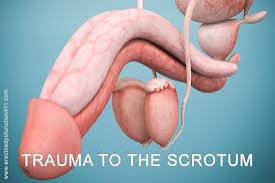Testicular Trauma
Testicular trauma refers to any injury to one or both testicles, which are vulnerable due to their exposed location in the scrotum. This condition can range from minor bruising to severe damage.
---
Causes
1. Blunt Trauma:
Most common cause, often from sports injuries, accidents, or direct impact.
2. Penetrating Trauma:
Caused by sharp objects, gunshots, or stabbing injuries.
3. Degloving Injuries:
Severe injuries where the scrotal skin is torn off, often in industrial accidents.
4. Testicular Rupture:
A tear in the testicle caused by a strong impact, leading to internal bleeding and tissue damage.
5. Torsion or Twisting:
Indirect trauma may result in testicular torsion, cutting off blood supply.
---
Signs and Symptoms
1. Severe Pain:
Sudden, intense pain in the testicles after an injury.
2. Swelling and Bruising:
Noticeable enlargement and discoloration of the scrotum.
3. Nausea and Vomiting:
Commonly associated with severe testicular pain.
4. Hematocele:
Blood pooling in the scrotum, causing additional swelling.
5. Testicular Deformity:
An irregular shape or position of the testicle may indicate rupture.
6. Difficulty Urinating:
Possible if the injury involves the urethra.
7. Fever:
Suggests infection in cases of penetrating trauma.
---
Effects
1. Testicular Rupture:
Severe damage can lead to permanent loss of the testicle if untreated.
2. Infertility:
Damage to the testicle or its blood supply can impair sperm production.
3. Infection:
Open wounds or untreated hematoceles can lead to infection or abscess formation.
4. Chronic Pain:
Persistent discomfort may develop due to nerve damage or scarring.
5. Psychological Impact:
Anxiety or trauma-related stress, especially if fertility or appearance is affected.
---
Solutions
1. Immediate First Aid:
Rest and lie down to reduce pressure.
Apply cold packs wrapped in a cloth to the scrotum to reduce swelling and pain.
2. Medical Treatment:
Pain Relievers: NSAIDs like ibuprofen for mild to moderate pain.
Scrotal Support: Wear supportive underwear to minimize discomfort.
3. Emergency Care:
Seek immediate medical attention for severe pain, swelling, or suspected testicular rupture.
4. Surgical Intervention:
Testicular Repair: Surgical reconstruction to repair ruptured tissue.
Orchiectomy: Removal of the damaged testicle in severe cases.
Drainage: Removal of blood or fluid buildup in the scrotum (hematoceles).
5. Follow-Up:
Ultrasound imaging to assess testicular blood flow and tissue integrity.
Regular checks to monitor healing and functionality.
---
Prevention
1. Protective Gear:
Wear an athletic cup during sports or activities with a risk of impact.
2. Avoid Risky Activities:
Minimize exposure to situations where trauma is likely.
3. Awareness:
Take care when lifting heavy objects or engaging in physical activities that strain the groin.
4. Prompt Treatment of Minor Injuries:
Seek early care for any testicular discomfort to prevent complications.
---
If testicular trauma occurs, do not ignore symptoms. Prompt evaluation and treatment can prevent long-term complications, including infertility and chronic pain.


